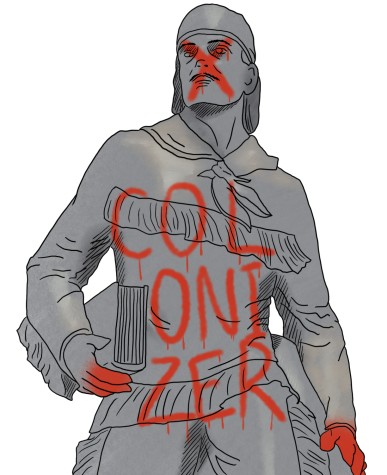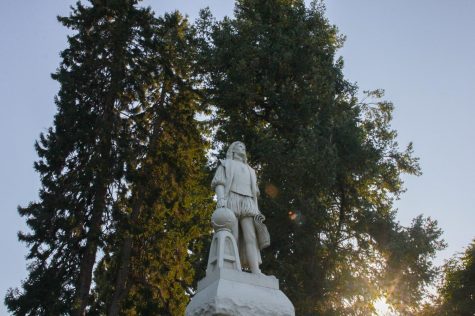County Commissioners vote to keep Columbus statue
October 28, 2021
On Monday, Oct. 18, Walla Walla’s Board of County Commissioners, Todd Kimball, Greg Tompkins and Jennifer Mayberry voted to keep the Christopher Columbus statue situated in front of the Walla Walla County Courthouse on Main Street.
The Italian Heritage Association of Walla Walla, one of the major proponents of maintaining the statue, spoke of their enthusiasm for this decision as a preservation of their community’s history.
“[We are] elated to see that the Columbus statue will remain on the Walla Walla courthouse lawn and, according to our organization, continue to serve as a visible symbol of hope for all current and future US immigrants, celebrate Walla Walla’s Italian heritage and the Italian community’s contributions to the Walla Walla Valley,” the association said in a message to The Wire.
Erasing History
Commissioner Kimball echoed that the statue is a symbol for recognizing the racial discrimination Italian immigrants faced as they integrated into the Walla Walla Valley. Kimball believes that removing the monument would be an act of erasing this history.
“The reason the statue was purchased by the Italians and erected on County property was a recognition that the Italians were now part of our community. They had been discriminated against in this community for many years (our history),” Kimball said in an email to The Wire. “Why (you may ask) remove a symbol of a group of people tearing down the walls of discrimination; it should be celebrated.”
Anna Lueck, a member of We Belong Walla Walla (WBWW)—a community group that aims to have the statue removed—noted they were expecting the result of the meeting. She anticipated some of the reasons the commissioners raised, though she still felt these explanations were hypocritical.
“Keeping statues like this up and perpetuating the myth of these people as uncomplicated heroes requires erasing a lot of other peoples’ history by default,” Lueck said. “Particularly both the native communities that Columbus himself tortured, enslaved and murdered, but also the generations of native communities across the continent since then that have just lived with those effects.”
Junior Cheysen Cabuyadao-Sipe, President of Whitman’s Indigenous Peoples’ Education and Culture Club (IPECC), echoed these sentiments and encouraged a broader perspective when considering history.
“Erasing history, who’s history?” Cabuyadao-Sipe said. “History is much more ambiguous, complex and nuanced than we all think it is. It’s [important to] tell all of the parts of history rather than just the westernized, Euro-American, belongs-to-the-victor story. Bring in Indigenous voices. Bring in Indigenous histories.”
Nobody’s Perfect
During the Oct. 18 meeting, Kimball expressed that historical figures, good or bad, present a fruitful opportunity for education and that erasing such histories is not the appropriate way to learn or achieve civil dialogue.
“Was Columbus perfect, obviously not. None of us are!” Kimball said. “A quote I found interesting from Neil deGrasse Tyson about Christopher Columbus’ voyage ‘Him coming to America was the most significant thing to ever happen in our species.’”
The quote Kimball referenced was originally stated in a podcast episode from The Joe Rogan Experience released in May 2021. In the episode, Tyson, also stated “It’s the most significant thing to happen in our species otherwise we’d still be two stranded branches of humans,” continuing by elaborating on Columbus’s voyage as an impressive feat in the scope of human evolution. He also commented that “Obviously there’s a lot to blame Columbus for but he just happened to be the guy who did it first.”
Cabuyadao-Sipe does not see Columbus’s imperfections as so quickly excusable, reflecting on the long-lasting consequences of Columbus’s actions.
“These mistakes have resulted in the literal decimation of not only just Indigenous peoples, but of the lands as well,” Cabuyadao-Sipe said. “Yes, they may be mistakes, but those mistakes have affected not only immediate lives and populations but generations. The structures in place make it harder for people of Black, Indigenous, people of color (BIPOC) identities to be able to actually thrive, to even live.”
The Importance of Civil Conversation
Kimball considered how much he learned about community opinions on this issue. He stated at the Commissioner’s meeting that he reviewed each of the 600+ letters received during the 30-day review period, but felt the tone used in these messages did not leave room for an open-minded, civil conversation.
“The past several months have been a real eye opener, several of those that wanted the Columbus statue removed could not have been more disrespectful and condescending to the Commissioners,” Kimball said. “Letters received ‘demanded’ that we remove the Columbus statue; that is not how a civilized conversation about options related to the statue can start. I did everything in my power to educate myself as to the nature of the passion behind both sides of this issue.”
Emily Tillotson, another member of WBWW, considered Professor Stan Thayne’s Indigenous Politics class’s Zoom lectures on the history of Columbus Day and Indigenous Peoples’ Day and Whitman’s Unmaking Whitman, Unlearning the Myth series as recent learning opportunities on this topic.
“There have been excellent opportunities, free and open to the public, all streamed online, very COVID-19-friendly, and the commissioners were nowhere to be found,” Tillotson said. “This is just far beneath the expectations I have for my public officials.”
In the meeting, Kimball stated that he was unable to gain access to Thayne’s students’ presentations, despite the live lectures and recordings of them being publicly accessible. Lueck reiterated that they would hope for more intention in the Commissioners’ self-education on the topics they vote on and that the community cares about.
“It should be your job to seek out all of the information you need to make a decision as opposed to the information that’s logistically easy for you to get and the information that’s emotionally easy for you to take in,” Lueck said.
Having Civil Dialogue
Kimball emphasized the importance of having a civil dialogue on divisive topics within the community and across the nation.
“We can disagree without slamming the door on someone with a different point of view. When someone comes at you with a point of view and is unwilling to listen and try to understand an opposing view, we lose the opportunity to learn from one another,” Kimball said. “I have found that I do not learn anything when I am talking.”
Lueck, however, cited the demonstrated disallowance for discussion from the Commissioners.
“They don’t seem to be fostering or facilitating a discussion at all,” Lueck said. “We were given seven minutes to comment…they also said several times that this is not a debate, this is not up for discussion. We’ll have those seven minutes and nothing else.”
Victoria Lidzbarski, another member of WBWW, noted the lack of civility from the commissioners themselves.
“The callousness of one of the commissioners when he was talking about why the statue should be maintained and what struck me about that was that even if we ‘got our way’ and the statue was removed, as long as he thinks that way and can continue to be that callous and that cruel and willfully ignorant of the impact of his words, of the statue and of colonialism generally, then it doesn’t really matter if we got the statue down,” Lidzbarski said.
Framing Community Voices
The members of WBWW also raised concerns over how the Commissioners went about taking in community voices on this subject. Of the petitions—both for and against statue removal—that have circulated, over 5,600 signatures to take down the monument have been collected. During the Oct. 18 meeting, only the 1,900 signatures to keep the statue were discussed. The online petitions were not considered by the Commissioners as they were not gathered within the 30-day window, according to Tillotson.
“They just chose to frame it so they could frame out all of the other voices,” Tillotson said. “When we want to maintain white supremacy, we frame it to say ‘This group of voices is what we’re going to hear during these dates, in this way, and that’s how we’re going to frame everybody else out of the picture.’”
Furthermore, if a letter did not explicitly state the words of being for or against the statute, despite a clear explanation of their desires, they were not counted.
“What we have is the preferences of a group of white folks, the Italian Heritage folks, really trumping the preferences of our Native community,” Tillotson said. “That to me, is what modern institutional racism looks like, is the preferencing and advantaging of a white group’s preferences over the preferences of people of color and Native Americans.”
WBWW is drafting plans of how to move forward following this decision and hopes to partner with Whitman students who have been reckoning with the school’s own contentious Marcus Whitman statue.
“We’re not done, we don’t see this as being finished,” Lidzbarski said.
Whitman students interested in working with WBWW can sign up on the contact list for We Belong Walla Walla using this Google Form or reach them at [email protected].







Joan Tatum • Oct 31, 2021 at 1:20 am
What is ironic is this statue was erected as a reaction to the Italian immigrants lynched in New Orleans. The local immigrants in an attempt to be legitimatized erected a statue to honor an unhonorable person who was responsible for the lynching of hundreds of indigenous people. The persecuted honored the persecutor.